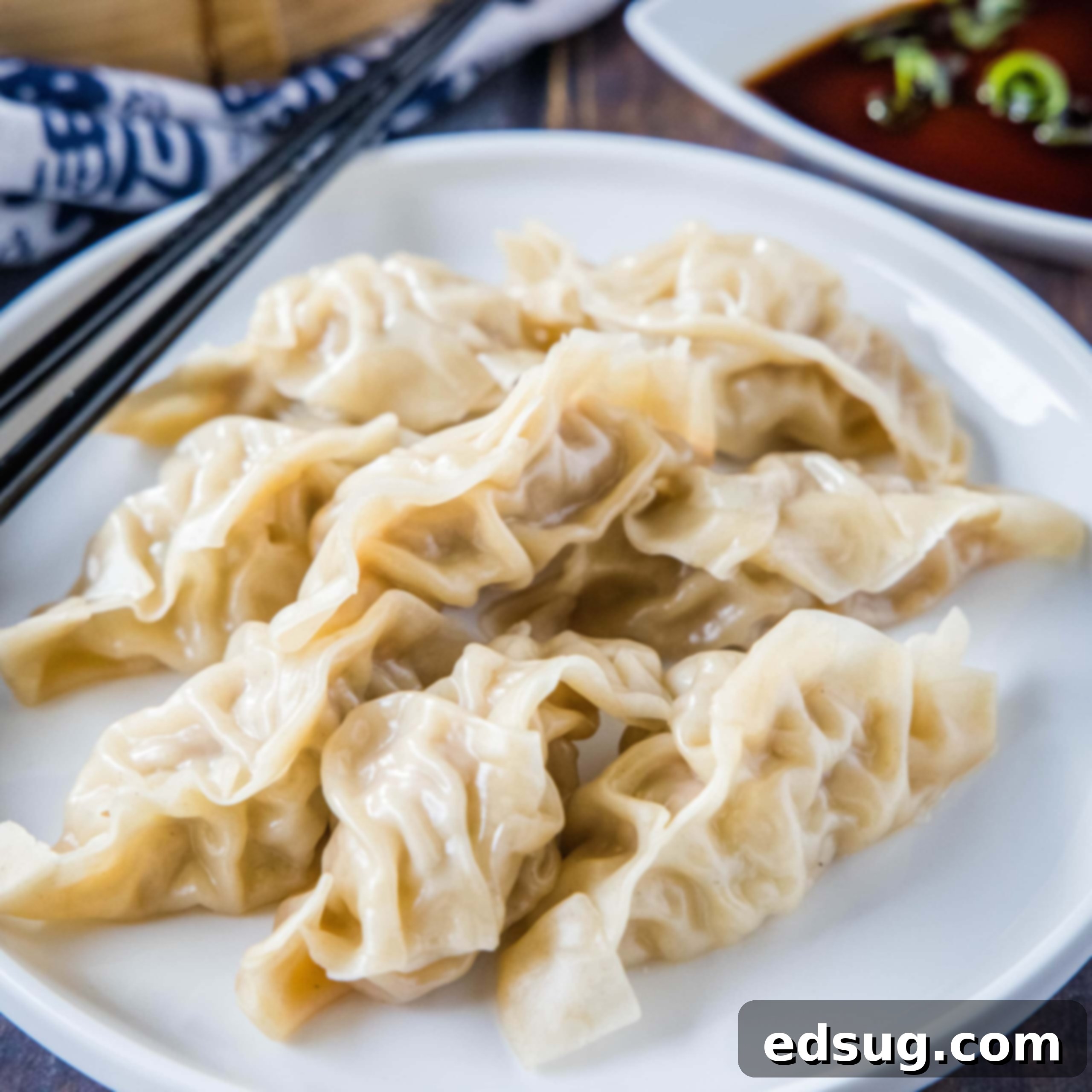Homemade Steamed Pork Dumplings: Your Guide to Authentic Asian Comfort Food
There’s a universally acknowledged delight in biting into a perfectly crafted dumpling. For many, including myself, dumplings represent a pinnacle of comfort food, a culinary journey that evokes cherished memories and a profound appreciation for Asian cuisine. My own fascination was cemented during a memorable trip to China a few years ago, where I made it my mission to sample every dumpling variety imaginable. From the delicate, translucent skins to the rich, savory fillings, each bite was a revelation. This passion extends to Japanese Gyoza, another essential dish I seek out on menus and love to prepare at home.
Making steamed pork dumplings from scratch might seem like a daunting task, but I promise it’s an incredibly rewarding experience. The beauty of this particular recipe lies in its simplicity and the ability to produce a large batch that can be frozen for future enjoyment. While the process of filling and folding can be a little meditative and time-consuming, investing that extra effort means you’ll have a freezer full of delicious, ready-to-steam dumplings, perfect for a quick weeknight meal or an impromptu gathering. It’s a true culinary superpower!
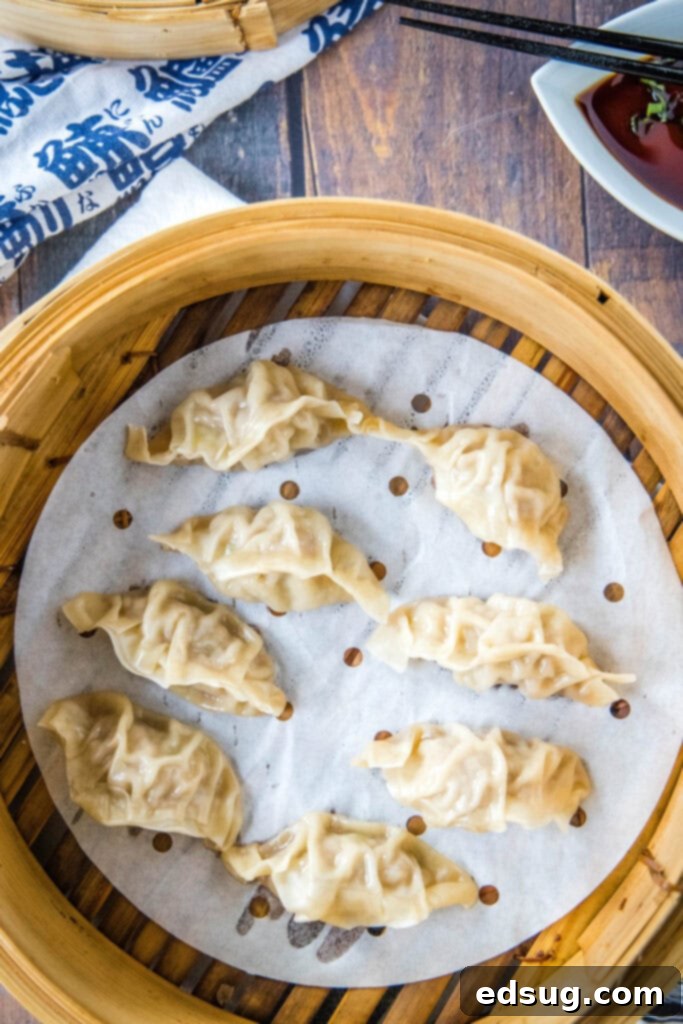
One of the best aspects of these homemade pork dumplings is how accessible the ingredients are. You don’t need to visit specialty Asian markets or hunt down obscure items. The filling is made with readily available staples that you can find at virtually any major grocery store. My goal is always to create delicious, authentic-tasting dishes from around the world without requiring an extensive treasure hunt for ingredients. This recipe perfectly embodies that philosophy, bringing the flavors of Asia directly to your kitchen with ease.
The ingredient that sometimes poses the slightest challenge, yet has become increasingly common, is the wonton wrapper. Fortunately, most supermarkets now stock them, typically located near the fresh produce section. Whether you opt for square or round wrappers, either will work beautifully and result in incredibly flavorful dumplings. While traditional recipes might call for specific wrapper types, the convenience and versatility of store-bought wonton wrappers make this recipe a fantastic entry point for dumpling enthusiasts.
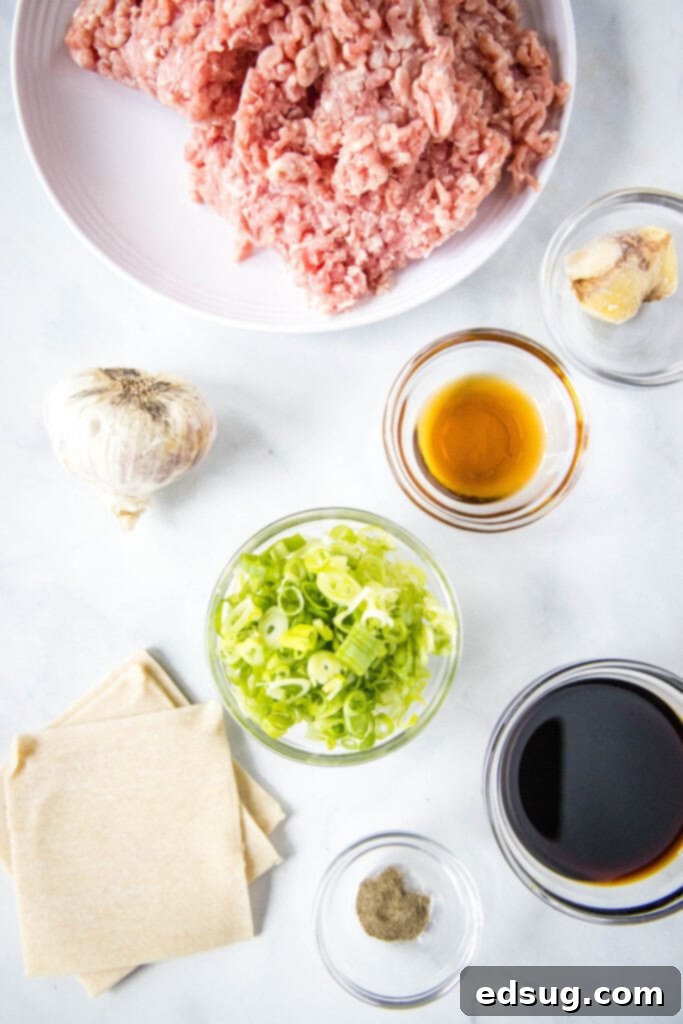
Crafting the Perfect Pork Dumpling Filling
The heart of any great dumpling lies in its filling, and these steamed pork dumplings boast a wonderfully balanced and savory mixture. The combination of fresh, aromatic ingredients with succulent ground pork creates a flavor profile that is both comforting and exhilarating. Here’s what you’ll need for the filling:
- Ground Pork: The star of the show, providing a rich, tender base.
- Fresh Ginger: Adds a pungent, zesty kick and distinctive Asian aroma.
- Garlic: Essential for depth of flavor and aromatic complexity.
- Green Onions (Scallions): Offers a mild oniony sweetness and a touch of freshness.
- Soy Sauce: Contributes umami, saltiness, and a savory backbone.
- Sesame Oil: Imparts a nutty, toasted flavor that is quintessential to Asian cuisine.
- Black Pepper: A simple seasoning to enhance the overall taste.
- Wonton Wrappers: The pliable casing that holds all the deliciousness together.
Each ingredient plays a crucial role in building the layered flavors that make these dumplings so irresistible. The fresh ginger and garlic are key to that authentic Asian taste, while the green onions provide a subtle bite and vibrant color. The soy sauce and sesame oil tie everything together, infusing the pork with a savory, aromatic essence that’s simply divine.
Beyond the dumplings themselves, an outstanding dipping sauce is an absolute must. While store-bought options abound, taking a couple of minutes to whip up a homemade sauce elevates the entire experience. My quick and easy version, detailed in the recipe card below, perfectly complements the rich filling, adding a bright, tangy, and savory counterpoint.
The Essential Homemade Dipping Sauce
A great dumpling deserves an equally great dipping sauce. This simple yet flavorful sauce can be prepared in minutes and truly enhances the taste of the steamed pork dumplings. It balances savory, tangy, and aromatic notes that cut through the richness of the pork filling.
- Soy Sauce: The primary base, providing saltiness and umami.
- Water: Helps to thin the sauce slightly and mellow its intensity.
- Rice Vinegar: Adds a crucial tanginess and acidity.
- Green Onion (Scallion): For a fresh, mild onion flavor and visual appeal.
- Sesame Oil: A drizzle adds a wonderful nutty aroma.
Simply combine all these ingredients, give them a good stir, and you’ll have a delightful dipping sauce ready in under two minutes. For those who enjoy a little extra kick, we often add a touch of hot chili oil to our individual dipping bowls. This allows everyone to customize their level of spice, making it perfect for all palates.
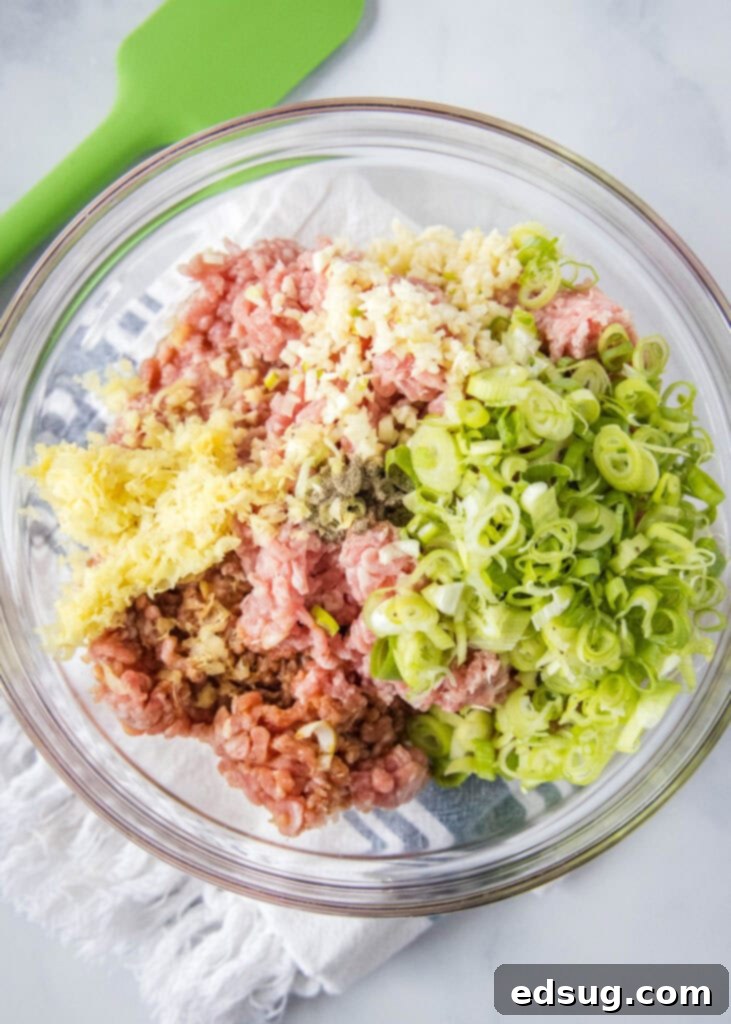
Step-by-Step Guide: How to Make Steamed Dumplings
Making steamed dumplings is an enjoyable process that, with a little practice, becomes incredibly simple. The key is in the preparation of the filling and the gentle art of folding. Follow these steps for delicious, perfectly formed dumplings:
- Prepare the Filling: In a large bowl, thoroughly combine the ground pork, finely chopped green onions, grated fresh ginger, minced garlic, soy sauce, sesame oil, and a dash of black pepper. Mix until all ingredients are evenly distributed and the mixture is cohesive. Using your hands ensures everything is well incorporated without overworking the meat.
- Portion the Filling: Lay out your wonton wrappers on a clean, dry surface. Place approximately two teaspoons of the prepared pork filling directly in the center of each wrapper. It’s important not to overfill, as this can make folding difficult and cause the dumplings to burst during steaming.
- Moisten the Edges: Dip your finger in a small bowl of water and lightly moisten the outer quarter-inch edge of the wrapper all the way around. This creates a seal when you fold the dumpling. Remember, just a light touch is needed; too much water can make the wrapper soggy.
- Fold and Pleat: Carefully fold the wrapper in half over the filling, creating a half-moon shape. Gently press the edges together to form a seal. Then, starting from one end of the folded edge, use your thumb and forefinger to create small pleats, about a quarter-inch apart, along the sealed edge. As you make each pleat, press down firmly but gently to seal the dough. Continue until you’ve pleated across the entire curved edge, creating about 6 distinct pleats.
- Shape the Base: Once folded and pleated, gently press the bottom of the dumpling flat. This allows it to sit upright in the steamer and ensures even cooking. Place each finished dumpling on a baking sheet lined with parchment paper, ensuring they don’t touch each other.
- Steam to Perfection: If you’re using a bamboo steamer, line it with parchment paper. Parchment paper with pre-cut holes like this one works exceptionally well, or you can cut small squares for each dumpling to prevent sticking and allow steam circulation. Fill a large skillet or wok with about 2 inches of water, place the bamboo steamer basket over the pan, and bring the water to a boil. Once boiling, reduce the heat to medium to maintain a steady steam. Place the dumplings in the steamer, cover the basket with its lid, and cook for 12-15 minutes, or until the pork filling is cooked through and the wrappers are translucent and tender.
The beauty of the steaming method is that it yields incredibly tender and juicy dumplings, without the added oil of pan-frying. This makes them a lighter, yet equally satisfying, option.
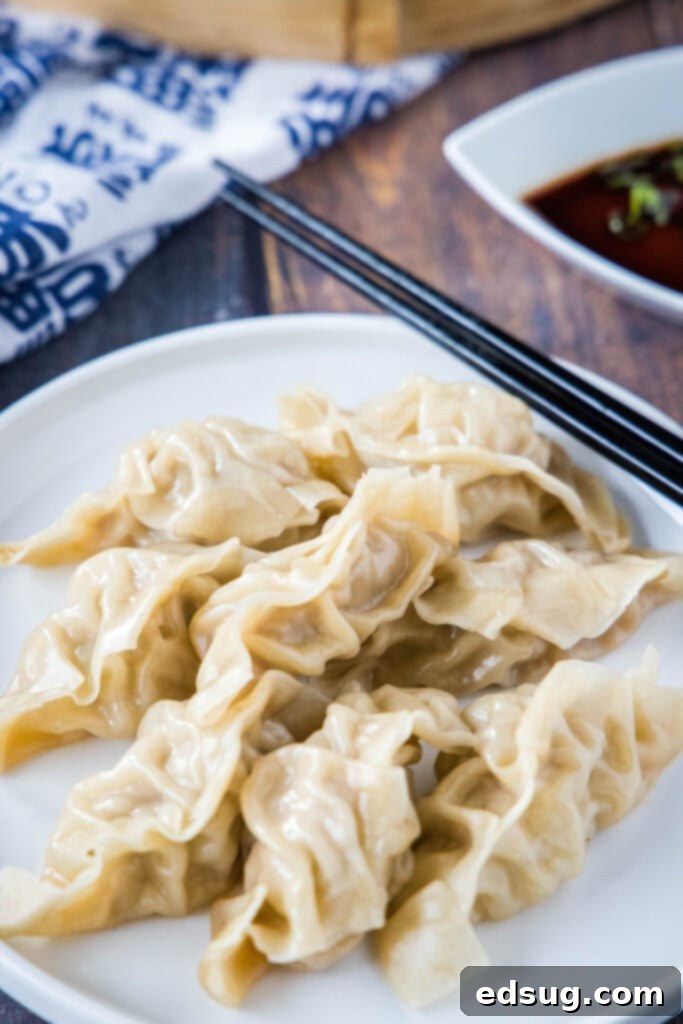
Storing and Freezing Homemade Pork Dumplings for Later
One of the most practical benefits of making your own dumplings is the option to prepare a large batch and store them for later. This makes the initial effort incredibly worthwhile, as you’ll have a convenient, delicious meal ready whenever you need it. The process of filling and folding can be quite relaxing, so why not make a double or triple batch and stock your freezer?
To freeze freshly made, uncooked dumplings:
- Once you have filled and folded all your dumplings, arrange them in a single layer on a baking sheet lined with parchment paper. Ensure there is a small space between each dumpling to prevent them from sticking together.
- Cover the baking sheet loosely with plastic wrap.
- Place the baking sheet in the freezer for at least two to four hours, or until the dumplings are completely frozen solid. This step is crucial for preventing them from clumping together in a storage bag.
- Once frozen, transfer the solid dumplings from the baking sheet into a freezer-safe, airtight storage bag or container. Label the bag with the date.
- Frozen dumplings can be stored for up to 2-3 months without a significant loss in quality.
Cooking frozen dumplings is just as straightforward as cooking fresh ones. You follow the exact same steaming instructions, but you’ll need to increase the cooking time by a few extra minutes, typically 15-18 minutes, depending on their size and thickness. There’s no need to thaw them beforehand, making them an incredibly convenient option for a quick and satisfying meal anytime.
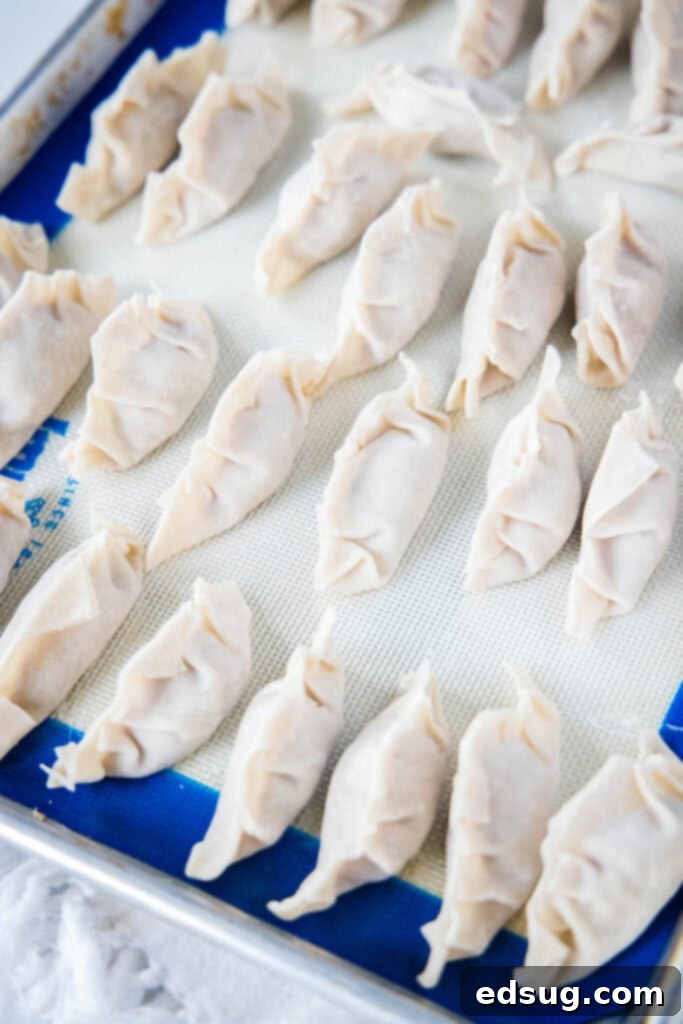
Wonton Wrappers vs. Gyoza Wrappers: Understanding the Difference
When it comes to wrappers for your Asian dumplings, you generally have two main choices: wonton wrappers and gyoza wrappers. Both will work well for this recipe, but there are subtle differences to consider that might influence your preference or availability.
Gyoza Wrappers: These are traditionally round and tend to be slightly thicker and more pliable than wonton wrappers. Their texture allows them to hold up exceptionally well to steaming, and they often develop a lovely chewiness. They are the ideal choice if you’re aiming for a dumpling that closely resembles Japanese Gyoza. Gyoza wrappers are more commonly found in the frozen section of Asian grocery stores. If you have access to an Asian market, I recommend seeking them out for their superior texture and resilience during steaming.
Wonton Wrappers: These are typically square, though round versions are also available. They are generally thinner and a bit more delicate than gyoza wrappers, which can result in a more tender, almost melt-in-your-mouth dumpling after steaming. The significant advantage of wonton wrappers is their widespread availability; you can find them in almost every major grocery store, usually in the refrigerated produce section. This makes them a much more convenient option for home cooks who might not have easy access to specialty Asian markets.
Ultimately, both types of wrappers will yield delicious steamed pork dumplings. Don’t let the choice intimidate you; simply use what you can easily find. If you have the option, experimenting with both might help you discover your personal favorite!

Choosing the Right Steamer for Your Dumplings
To achieve perfectly steamed dumplings, having the right equipment makes a significant difference. While there are various options, some are more traditional and efficient than others.
Bamboo Steamer: Without a doubt, a bamboo steamer is the best tool for steaming dumplings. These inexpensive, stacked baskets are excellent for several reasons: they allow steam to circulate evenly, absorb excess moisture to prevent soggy dumplings, and are incredibly versatile for steaming various foods. You’ll want a bamboo steamer basket that fits snugly over a large skillet or wok, which you fill with about 2 inches of water. This setup allows you to steam for the recommended 12-15 minutes without the water boiling dry. I’ve found myself using my bamboo steamer far more often than I initially expected, not just for fresh dumplings but also for quickly reheating frozen store-bought varieties.
Vegetable Steamer Basket: Don’t despair if you don’t own a bamboo steamer! For years, I successfully used a basic collapsible vegetable steamer basket. These metal baskets expand to fit into almost any pot, creating a raised platform above the water. The principle is the same: you need something that suspends the food over boiling water, allowing the steam to fully circulate and cook the dumplings thoroughly. Place the steamer basket into a pot with about 1-2 inches of water, ensuring the water level is below the bottom of the basket, then cover the pot with a tight-fitting lid.
Regardless of the steamer you use, always remember to line the bottom with parchment paper or a bed of cabbage leaves to prevent the dumplings from sticking. This simple trick ensures your beautiful dumplings remain intact when transferred from the steamer to your plate.
Customizing Your Dumpling Filling: Other Meat Options
While ground pork is our absolute favorite for these steamed dumplings and delivers a classic, rich flavor, this recipe is incredibly versatile. You can absolutely experiment with other types of ground meat or even add seafood to create different flavor profiles that suit your preferences or dietary needs.
- Ground Turkey: For a leaner option, ground turkey works wonderfully. It absorbs the flavors of ginger, garlic, and soy sauce beautifully, resulting in a lighter yet equally satisfying dumpling.
- Ground Chicken: Similar to turkey, ground chicken is another excellent poultry alternative. Its mild flavor provides a fantastic canvas for the vibrant Asian seasonings.
- Combination of Meats: Feel free to mix and match! A blend of ground pork and chicken, or pork and shrimp, can add complexity and texture to the filling.
- Shrimp: For seafood lovers, finely chopped shrimp (either alone or mixed with ground pork or chicken) makes for an exquisite dumpling. The sweet, delicate flavor of shrimp pairs exceptionally well with the traditional aromatics.
- Vegetarian Options: While this recipe focuses on meat, the concept can be adapted for vegetarian fillings using finely chopped mushrooms, cabbage, tofu, or various vegetables, along with the same aromatic seasonings.
Don’t hesitate to get creative with your filling! The foundation of ginger, garlic, green onions, soy sauce, and sesame oil will ensure a delicious outcome no matter which protein you choose.
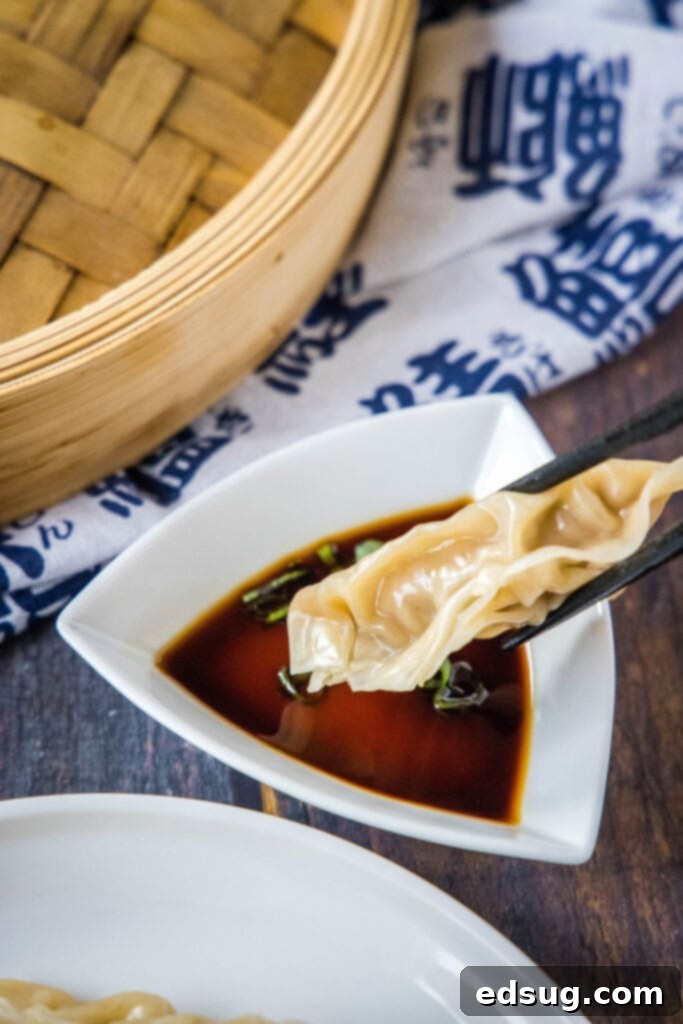
Expert Tips for Dumpling Success
Achieving perfectly tender, flavorful, and intact steamed dumplings is simpler with a few key techniques. These tips will help you avoid common pitfalls and ensure your homemade dumplings are a resounding success every time.
- Thoroughly Mix Your Filling: Unlike preparing ground meat for burgers where you want to handle it minimally to maintain a loose texture, dumpling filling benefits from thorough mixing. Get your hands in there and really combine the ground pork with the ginger, garlic, green onions, and sauces. This ensures all the flavors are evenly distributed and, more importantly, creates a cohesive mixture that is less likely to fall apart during cooking or when you bite into it. A well-mixed filling binds together beautifully.
- Don’t Use Too Much Water on the Wrappers: The instructions call for moistening the edges of the wrapper with water to create a seal, and this is crucial. However, moderation is key. You only need to barely moisten the outer quarter-inch of the wrapper. Avoid getting any excess water into the filling itself or making the wrapper overly wet, as this can lead to soggy dumplings and a less desirable texture after steaming. A light, damp finger is all that’s required.
- Always Line Your Steamer Basket with Parchment Paper: Steamed dumplings have a tendency to stick to the bottom of any steamer, whether it’s bamboo or metal. Lining your basket with parchment paper is an absolute must to prevent this. If you have parchment paper with pre-punched holes, use a full sheet. If not, cut small squares for each individual dumpling. This ensures that the dumplings don’t adhere to the steamer while still allowing plenty of room for steam to circulate freely and cook them evenly.
- Press Out Any Trapped Air: When you fold your wrapper over the filling, make sure you are pressing around the meat to remove any pockets of air. Trapped air inside the dumpling will expand during steaming, potentially causing the dumpling to burst open. Gently pressing the wrapper tightly around the filling as you fold and pleat helps create a more compact and stable dumpling that holds its shape beautifully.
- Ensure Adequate Water in Your Pan for Steaming: The amount of water in the skillet or wok beneath your steamer is vital. You need enough water to generate steam for the full cooking duration (12-15 minutes) without it completely evaporating. For a 10-inch skillet with a 9-inch bamboo basket, about 2 inches of water is usually sufficient. Once the water comes to a rolling boil, you can reduce the heat to medium to maintain a consistent, gentle steam, preventing rapid evaporation. Regularly check the water level if you are steaming multiple batches.
By following these detailed tips, you’ll be well on your way to making impressive, delicious homemade steamed pork dumplings that will rival your favorite restaurant versions!

More Irresistible Asian Recipes to Explore
If you’ve enjoyed making these steamed pork dumplings, you’re likely to appreciate the diverse and vibrant flavors of other Asian-inspired dishes. Here are some fantastic recipes from my kitchen that you might love to try next, perfect for expanding your culinary repertoire:
- Egg Drop Soup: A light, savory, and comforting classic, perfect as a starter.
- Chicken Lo Mein: A family-friendly favorite with tender chicken and flavorful noodles.
- Kung Pao Chicken: A spicy and savory stir-fry with peanuts and a delightful kick.
- Bourbon Chicken: Sweet, sticky, and incredibly delicious chicken that’s simple to make.
- Cashew Chicken: A hearty and satisfying dish with tender chicken and crunchy cashews.
- Garlic Beef Noodle Bowls: Flavorful beef and noodles, perfect for a quick and satisfying meal.
- Ground Mongolian Beef: A simplified take on a popular dish, packed with sweet and savory flavors.
- Air Fryer Egg Rolls: Crispy egg rolls made healthier in the air fryer, a perfect appetizer.
Each of these recipes brings its own unique flavors and textures, promising to delight your taste buds and transport you to the vibrant culinary landscapes of Asia. Happy cooking!
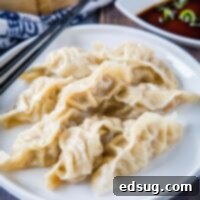
Asian Dumplings With Dipping Sauce
Ingredients
Dumplings
- 1 pound ground pork
- 3 green onions, thinly sliced
- 2 inch fresh ginger, grated
- 4 cloves garlic, minced
- 1/4 cup reduced sodium soy sauce
- 2 Tablespoon sesame oil
- 14 oz package wonton wrappers
Dipping Sauce
- 1/4 cup soy sauce
- 2 Tablespoon water
- 1 Tablespoon rice vinegar
- 1 green onion, thinly sliced
- 1 tsp sesame oil
Instructions
- Combine ground pork, green onions, garlic, ginger, soy sauce, sesame oil, and black pepper until well combined.
- Place about 2 teaspoons of filling into the center of a wonton wrapper.
- Next dip your finger in water and wet the outside 1/4 inch of the wrapper all the way around.
- While holding the wrapper, fold it in half over the filling. Then, starting at one edge, use your thumb and forefinger to make pleats about 1/4 inch apart.
- Once you make one pleat, press down gently to seal the dough together, and move onto the next one. In the end you will have about 3 pleats from one end to the other.
- Place the dumpling on a lined baking sheet, gently pressing down to flatten the bottom.
- Once all of your dumplings are ready, if you have a bamboo steamer line it parchment paper (this one with holes works really well, or cut small squares for each dumpling).
- Fill a large skillet with water, place the basket over the pan and bring to a boil.
- Cover the steamer basket and cook for 12 minutes.
Nutrition
Nutrition information is automatically calculated, so should only be used as an approximation.
Additional Info
I created a fun group on Facebook,and I would love for you to join us! It’s a place where you can share YOUR favorite recipes, ask questions, and see what’s new at Dinners, Dishes and Desserts (so that you never miss a new recipe)!
Be sure to follow me on Instagram and tag #dinnersdishes so I can see all the wonderful DINNERS, DISHES, AND DESSERTS recipes YOU make!
Be sure to follow me on my social media, so you never miss a post!
Facebook | Twitter | Pinterest | Instagram
.
